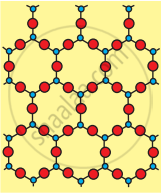Advertisements
Advertisements
Question
Which of the following is an amorphous solid?
Options
Graphite (C)
Quartz glass (SiO2)
Chrome alum
Silicon carbide (SiC)
Solution
Quartz glass (SiO2)
Explanation:
| Crystalline Silica (Quartz) | Amorphous Silica (Glass) | |
| 1. | Crystalline in nature. Also called quartz. | Light white powder. |
| 2. | All four corners of \[\ce{SiO4}\] tetrahedron are shared by others to give a network solid. | The \[\ce{sio4}\] tetrahedron are randomly joined giving rise to polymeric chains, sheets or three- dimensional units |
| 3. | High and sharp melting point (1710°C) | Does not have sharp melting point. On heating softens gradually to liquid. |

(a) Crystalline (Quartz)

(b) Amorphous (Quartz glass)
APPEARS IN
RELATED QUESTIONS
Why are solids rigid?
Why do solids have a definite volume?
Classify the following as amorphous or crystalline solids:
Polyurethane, naphthalene, benzoic acid, teflon, potassium nitrate, cellophane, polyvinyl chloride, fibre glass, copper.
Why is glass considered a super cooled liquid?
“Crystalline solids are anisotropic in nature″. What is the meaning of anisotropic in the given statement?
Which of the following is not a crystalline solid?
Which of the following statement is not true about amorphous solids?
Which of the following is true about the value of refractive index of quartz glass?
Under which situations can an amorphous substance change to crystalline form?
An ionic solid AB2 isomorphous to the rutile structure (a tetragonal system with the effective number of formula units = 2) has edge lengths of the unit cell of 4Å, 4Å and 7Å. The density of the substance is ______ mg/cc. (if its formula weight is 80. The NA = 6 × 1023 and express your answer in mg/cc using four significant digits.)
